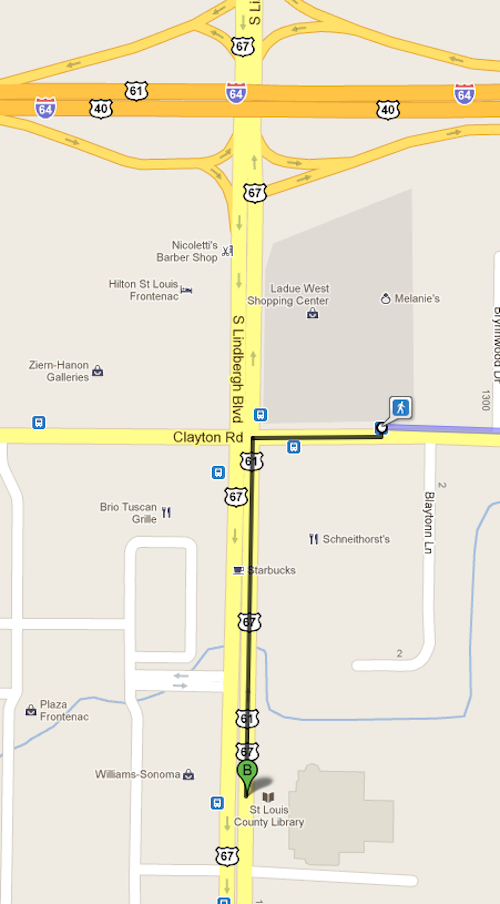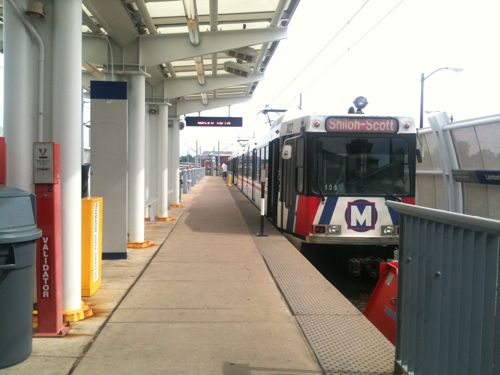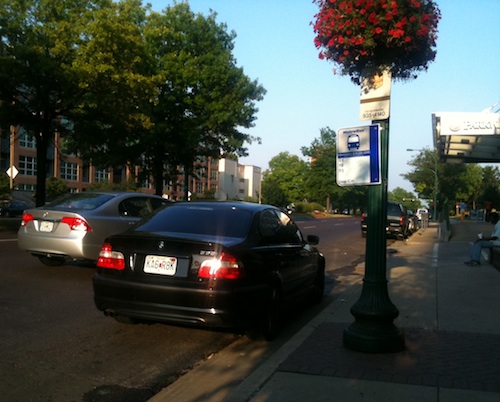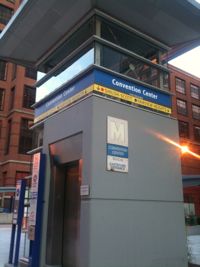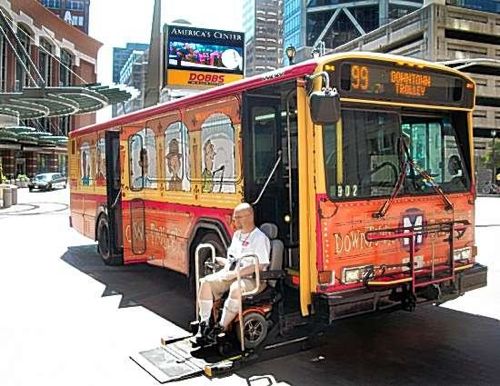Reaching the St. Louis County Library
I was thinking of attending a meeting being held tonight (7pm-9pm) at the headquarters of the St. Louis County Library located at 1640 South Lindbergh Blvd. The meeting is a St. Louis Aerotropolis Forum sponsored by the Citizens Alliance for Missouri Patriots (a closed Facebook group) that I’m NOT a member of:
Alliance of Tea Party and Patriot Group leaders and organizers in the State of Missouri who wish to combine forces in working together for our state’s sovereignty, who adhere to and believe in our founding fathers’ constitutional principles, government fiscal responsibility, individual unalienable rights, and a free market system. CAMP does NOT represent any one political party, but only the People of Missouri.
Here is the description of the Facebook event:
Concerned about the China Hub issue to be brought before our state legislators in the upcoming special session? For those in the local St. Louis metro area or across the state, you are invited to join us in hearing our panel of speakers who will be discussing and debating this topic which will affect every citizen in Missouri.
Scheduled panelists are Audrey Spalding from Show Me Institute, and David Roland from Missouri Freedom Center.
We are currently awaiting confirmation on panel speakers from the St. Louis Regional Chamber & Growth Association who are working to bring the China Hub to St. Louis.
The forum will be held in the library auditorium starting at 7pm and ending promptly at 9pm.
Scheduled Host is Mr. Rodney White, retired businessman, local author and speaker.
Please invite your neighbors, family, and friends who are wanting to know more about this new government tax credit.
I’d like to hear this perspective, Â I have three choices on how to get to the meeting:
- Drive my car
- Ask for a ride with someone else.
- Take public transit
Let’s look at each option.
1) Drive my car
This is the option 99% of those attending will use. But I try to use my car as little as possible, plus I have a narrow window between 6pm-9pm when I can drive to get the best insurance discount. I’d have to leave the event early if I drove to be home by 9pm.  And yes, Progressive knows exactly when I drive  because of the device I voluntarily plugged into my diagnostic port. Google Maps says the drive is 12.6 miles long and would take 18 minutes if I use I-64 or 13.7-14.2 miles (& 29-33 minutes) if I use surface streets.
2) Ask for a ride with someone else
This is a good option, one I wish more people would use rather than driving themselves. I know only one person on the attending list, but I know Ed Martin online only and I’m not sure I want to ask him or be at his mercy.
3) Take public transit
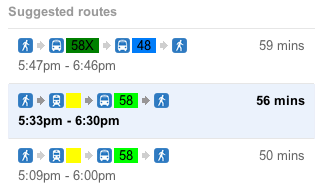 Finally my favorite option! I have two choices to reach the library via transit. The option that gets me there closest to the start time takes the longest (59 minutes) and would involve using MetroLink and two buses. The other option takes 50-56 minutes depending upon when I leave. Â This is twice as long as if I drove but from my view this is time I can read, check email, observe the city, etc.
Finally my favorite option! I have two choices to reach the library via transit. The option that gets me there closest to the start time takes the longest (59 minutes) and would involve using MetroLink and two buses. The other option takes 50-56 minutes depending upon when I leave. Â This is twice as long as if I drove but from my view this is time I can read, check email, observe the city, etc.
Since I’ve never been there in my power chair before I need to investigate the route in detail. The option that includes only one bus is more appealing than having to transfer from one bus to another so I looked at taking the #58 bus from the Clayton MetroLink/MetroBus station.
Seems simple enough, “walking” 3/10th of a mile is no big deal in my chair.
But when I looked at the aerial image and the street view is when problems became clear.
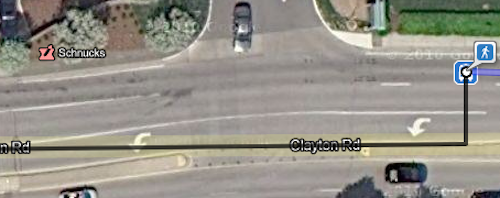
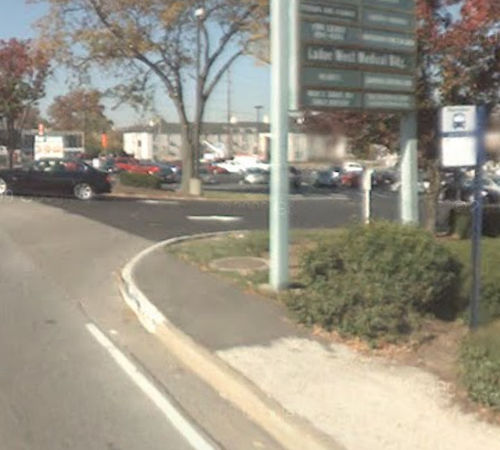 The street view shows curbs on both sides of the driveway, which means no deal. Â In looking back up at the aerial it seems the near side may have been fixed, but the far sides of the drive is unknown. This route is too uncertain.
The street view shows curbs on both sides of the driveway, which means no deal. Â In looking back up at the aerial it seems the near side may have been fixed, but the far sides of the drive is unknown. This route is too uncertain.
The other option is to take the #58X Express Bus to Big Bend & Kirkwood Rd then transfer to the #48 northbound on Kirkwood/Lindbergh.
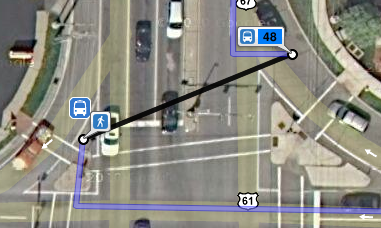 I’m pretty sure the stops are not as shown, but still the area has good sidewalks, ramps and crosswalks. I just need to figure out where to board the 48. Oh, just a bit to the north.
I’m pretty sure the stops are not as shown, but still the area has good sidewalks, ramps and crosswalks. I just need to figure out where to board the 48. Oh, just a bit to the north.
 And here we see a common problem. A large pad is provided as well as a shelter but the pad isn’t connected to the sidewalk. Suburban sidewalks are often just for show, not actual use, so having the sidewalk actually connect to points pedestrians would actually use is just radical thinking I suppose. Â My chair can deal with the grade change and grass but someone using a manual chair, walker or cane might have difficulty.
And here we see a common problem. A large pad is provided as well as a shelter but the pad isn’t connected to the sidewalk. Suburban sidewalks are often just for show, not actual use, so having the sidewalk actually connect to points pedestrians would actually use is just radical thinking I suppose. Â My chair can deal with the grade change and grass but someone using a manual chair, walker or cane might have difficulty.
The great thing is the #48 stops right in front of the library. I should be good from this point, right? Wrong!
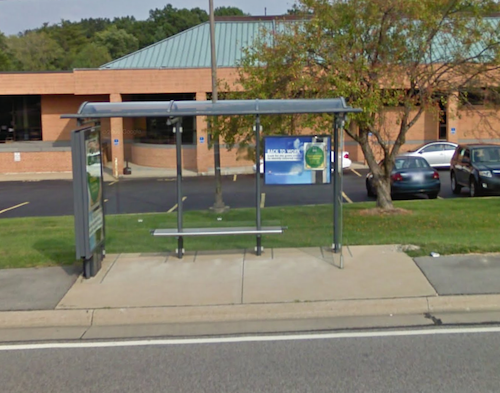
Where the bus stops there is no pedestrian route to the entrance. Perhaps a proper pedestrian access route exists somewhere in either direction?
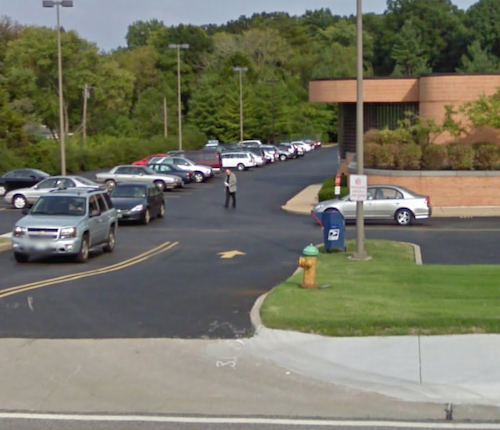
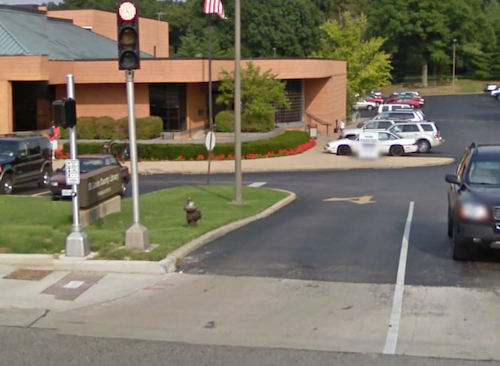
If I were to risk my life trying either vehicle drive I still have no clue where to find a ramp to reach and accessible entrance. Even the able-bodied would take a chance if they walked in one of the driveways. Walking to the library seems as American as apple pie, but not in St. Louis County apparently.
I checked out their accessibility page:
Buildings and Bookmobiles
What physical accommodations exist for persons with physical limitations?
- Handicapped-accessible parking
- Ramp entrances
- Power doors
- Elevators
- Accessible aisles and routes inside the buildings
- Accessible restrooms, water fountains, and public telephones
- Low service desks
- Specially-designed school bookmobile with wheelchair lift
No thought is given to pedestrians at all. My example is extreme in that I’m coming from a long distance. What about someone, like a senior or a child, in Kirkwood? What is the reverse route? Â Public buildings like libraries should demonstrate to others what is expected. Oh, I guess it does, they don’t expect pedestrians. But people do use these bus routes and stops and every transit rider is a pedestrian on at least one end of their trip.
St. Louis County and municipalities continue to spend money on sidewalks and ADA ramps but they fail to connect the dots! These new & improved sidewalks are mere roadside decoration  to give the appearance of walkability & accessibility.
I contacted the St. Louis County Library on the 26th about their lack of a pedestrian access route and they are tagged on the tweet of this post.
– Steve Patterson
